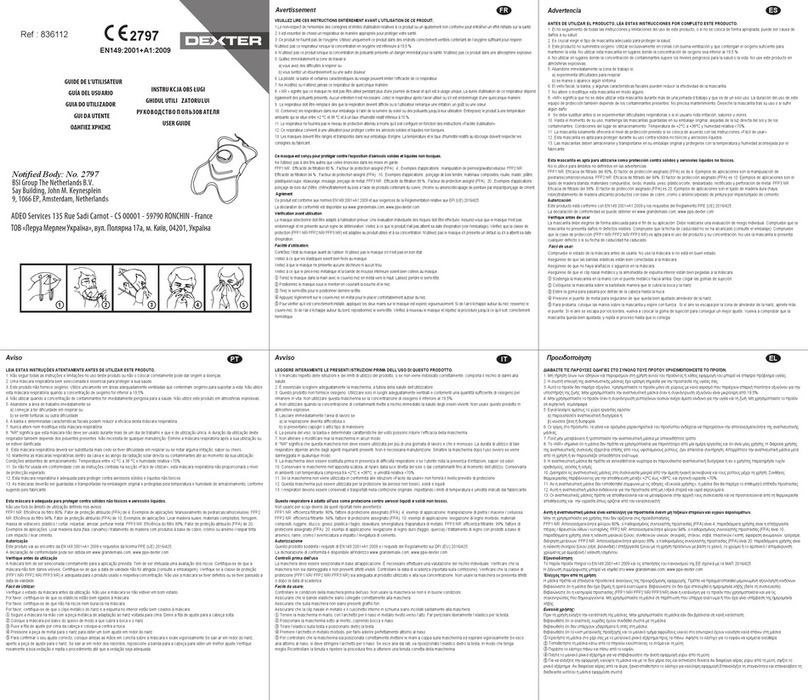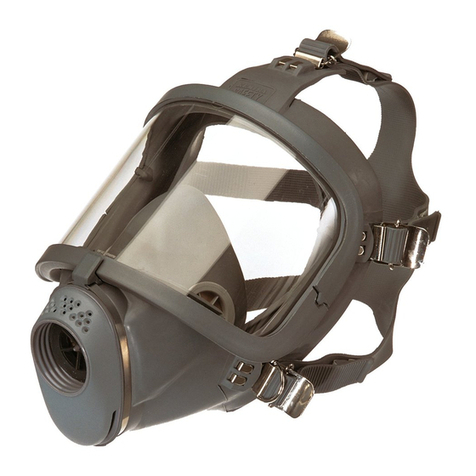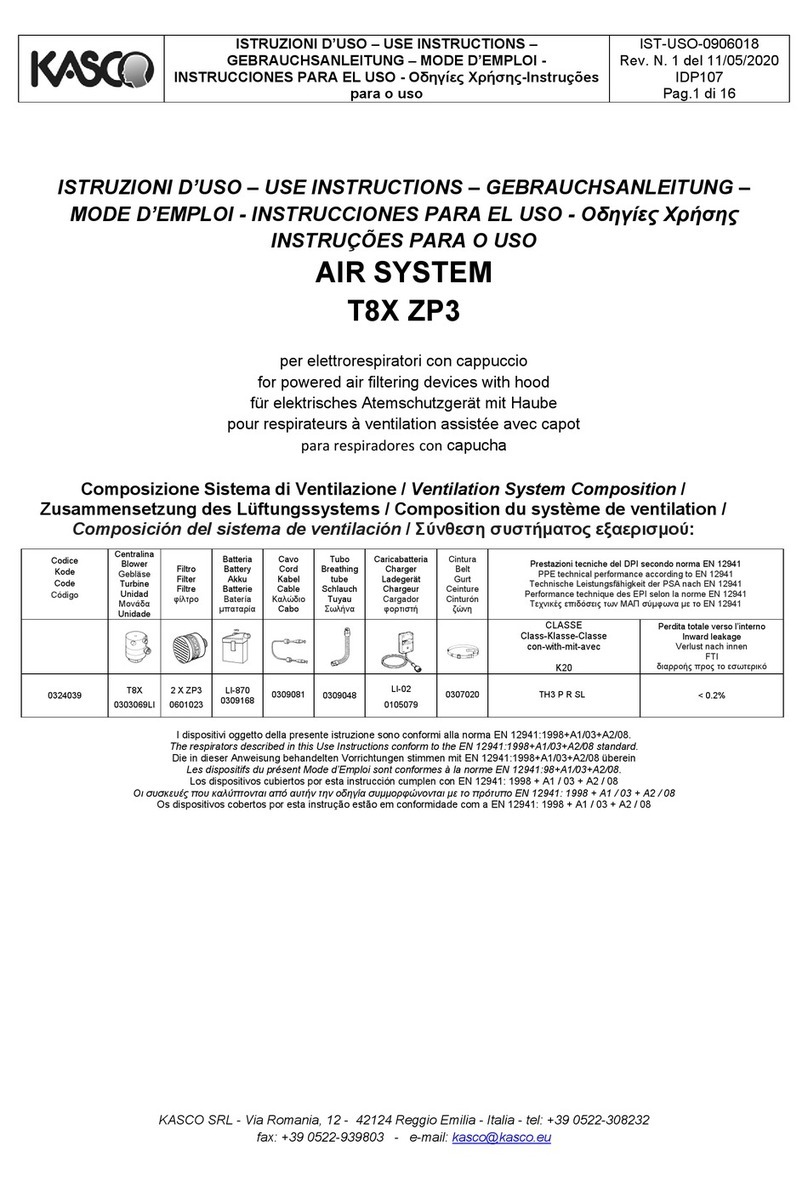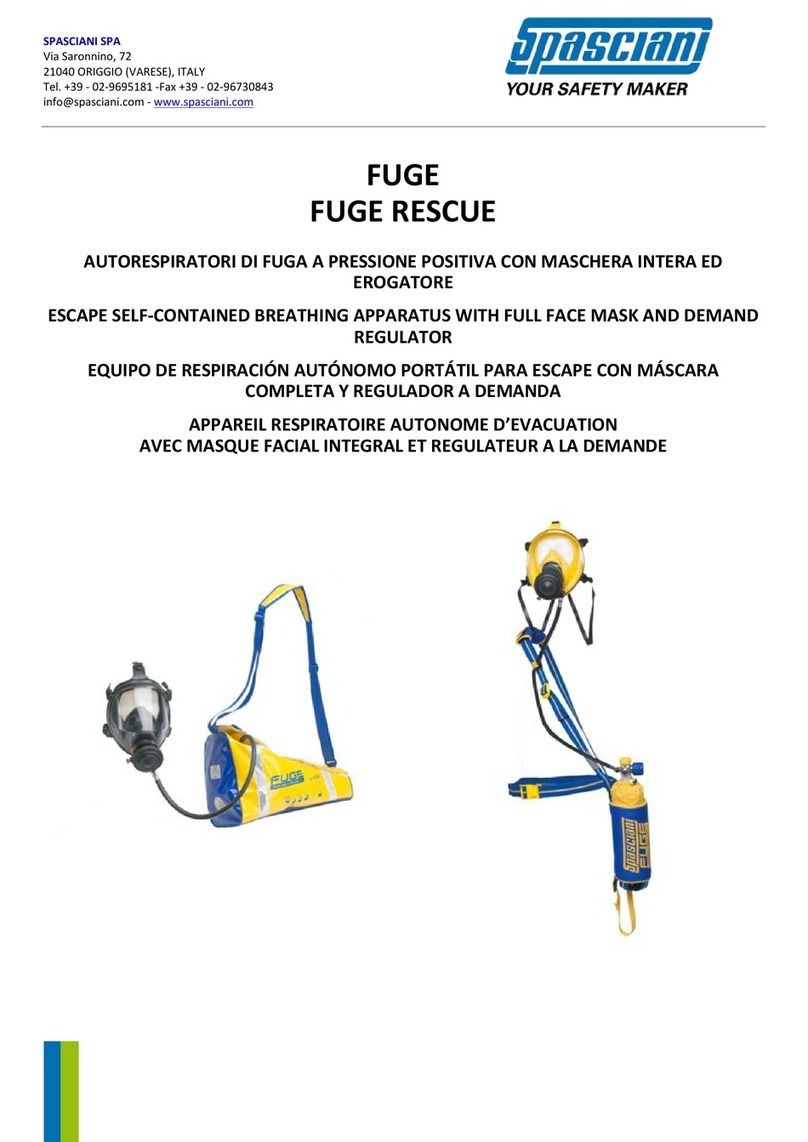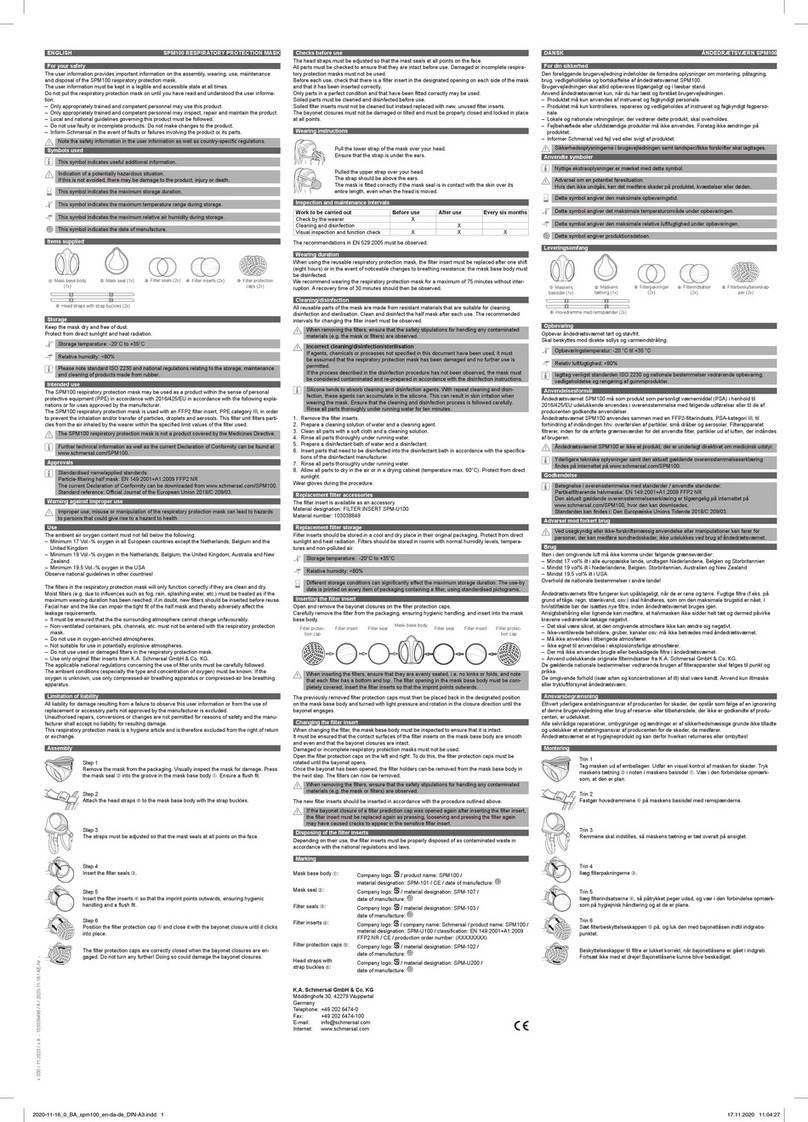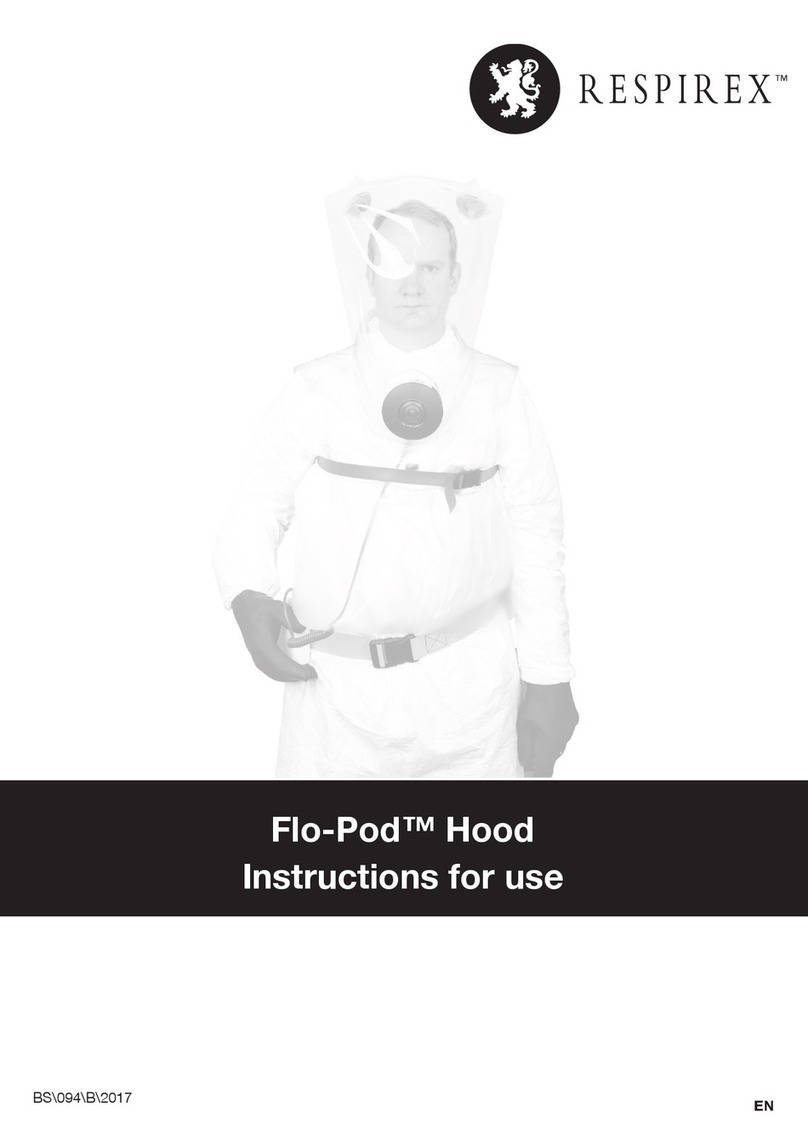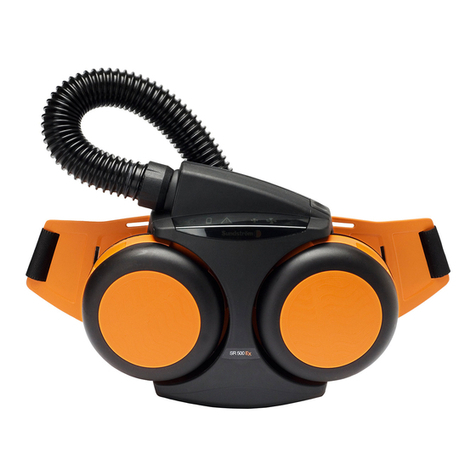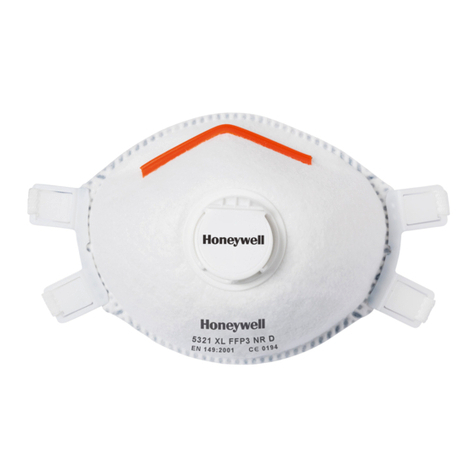DEZEGA CARBO S-60MP1-ISG-EUENEU-BKO User manual

CARBO
CHEMICAL OXYGEN
SELF-CONTAINED
SELF-RESCUER
APARAT UCIECZKOWY
Z TLENEM CHEMICZNIE
ZWIĄZANYM
KİMYASAL OKSİJENLİ
FERDİ KURTARICI CİHAZI
AUTORESCATADOR
AISLADO DE OXÍGENO
QUÍMICO
User manual
Instrukcja obsługi
Kullanım Kılavuzu
Manual de usuario
SKTB.02.СК5Е.00.00.000 РЭ-U1
IS 15803:2008
AS/NZS 1716:2012
0477
EN 13794:2002
TRPL ESEN
S-60MP1-I(N)SG-EUENEU
S-60MP1-I(N)SG-AUENAU
S-60MP1-ISG-EUPLPL
S-60MP1-I(N)SG-EUTRTR
S-60MP1-I(N)SG-EUESES
S-60MP1-ISG-INENIN
Red.18.03.2022_V2

COMPLIES WITH:
ZGODNY Z:
GEREKSINIMLERI KARŞILAR:
CUMPLE CON:
EN 13794:2002, REGULATION 2016/425/EU
IS 15803:2008
AS/NZS 1716:2012
USER MANUAL........................................................................................ 3
INSTRUKCJA OBSŁUGI......................................................................... 27
KULLANIM KILAVUZU ........................................................................... 47
MANUAL DE USUARIO.......................................................................... 69
PL
EN
TR
ES

CARBO
USER
manual
EN

CONTENTS
INTRODUCTION........................................................................................... 6
1. INTENDED USE ..................................................................................... 6
2. SAFETY PRECAUTIONS........................................................................ 6
3. TECHNICAL DATA.................................................................................. 7
4. RECOMMENDATIONS ON PRE-OPERATION INSPECTION................. 8
5. DESIGN.................................................................................................. 9
6. CARRYING METHODS ........................................................................ 10
7. RECOMMENDATIONS ON OPERATION,
RECORD AND ISSUANCE................................................................... 10
8. OPERATING PRINCIPLE...................................................................... 11
9. DONNING PROCEDURE .................................................................... 12
10. ESCAPE RULES AFTER DONNING THE SELF-RESCUER................. 15
11. CHANGEOVER PROCEDURE ............................................................. 16
12. TRAINING ............................................................................................ 16
13. SERVICE AND MAINTENANCE INSPECTION..................................... 17
14. DISPOSAL.............................................................................18
15. MARKING ............................................................................................ 19
16. STORAGE AND TRANSPORTATION RULES....................................... 20
17. MANUFACTURER’S WARRANTY........................................................ 20
18. INFORMATION FOR ORDER............................................................... 21
ANNEX A .................................................................................................... 22
ANNEX B .................................................................................................... 23
ANNEX C.................................................................................................... 24

DEZEGA CARBO
5
INTRODUCTION
The manual is intended to study the purpose, design and operating principle of CARBO chemical
oxygen self-contained self-rescuer (hereinafter – CARBO or the CARBO self-rescuer), the rules for its
use, maintenance and disposal.
CAUTION!
Any use of the CARBO self-rescuer requires accurate knowledge and strict compliance with this USER
MANUAL (hereinafter – manual). CARBO may only be used for the purpose, described in this manual.
Only in this case, the self-rescuer guarantees reliable protection of the user’s respiratory system in an
emergency.
1. INTENDED USE
CARBO self-rescuer is a personal respiratory protection device on chemically bound oxygen with
a closed breathing circuit, used for escape from irrespirable atmospheres that pose an Immediate
Danger to Life and Health (IDLH). It is suitable for carrying on a shoulder belt or on the waist. The SCSR
is used to protect the respiratory system during the escape when there is high density smoke from
fires, a high concentration of toxic gases, or a lack of oxygen in the atmosphere. CARBO is intended
for use in potentially explosive atmospheres.
The self-rescuer is designed for everyday carrying as well as storage at changeover stations along the
escape routes.
The self-rescuer complies with the requirements of EN 13794:2002 and REGULATION 2016/425/EU
(Category III).
EU declaration of conformity is supplied with the SCSR. Please contact manufacturer for copy.
The self-rescuer satisfies the requirements of AS/NZS 1716:2012, Technical reference guide (TRG) for
escape breathing apparatus for underground mining application. Registration number is indicated in
the Data Sheet which is supplied with each SCSR.
The device is suitable for industries with irrespirable atmosphere, including underground use.
CARBO self-rescuer is not designed for use during the routine operations.
CARBO is ready for immediate use.
The self-rescuer has no restrictions on use related to the physiological peculiarities of the users.
2. SAFETY PRECAUTIONS
Protect SCSR from mechanical damages, which may cause destruction of the regenerative cartridge,
lids and other components.
Do not store or leave the self-rescuer on operating mechanisms and equipment, as well as on heat
sources. The exception is carrying the SCSR during job performance.
Open SCSR only in case of emergency (for its intended use).
Keep unsealed, used or damaged SCSRs away from liquid or solid flammable materials, fuels and
lubricants.

CARBO DEZEGA
6
Unsealed self-rescuers (opened, damaged) where oxygen-containing product has direct contact
with air, shall be disposed in accordance with Section 14 «DISPOSAL». It is forbidden
to leave unsealed (opened) self-rescuers in the mine.
DANGER!
If the self-rescuer is damaged, the oxygen-containing product can cause ignition of coal, wood or other
flammable materials.
The notified body Eurofins Product Testing Italy S.r.l., Via Courgnè, n.21, 10156 TORINO, ITALY (No.
0477) performed the EU type-examination (Module B) and issued the EU type-examination certificate
№ EPT 0477.PPE.21/4588.
The PPE is subject to the conformity assessment procedure to type based on internal production
control plus supervised product checks at random intervals (Module C2) under surveillance of the
notified body Eurofins Product Testing Italy S.r.l., Via Courgnè, n.21, 10156 TORINO, ITALY (No. 0477).
3. TECHNICAL DATA
The key specifications of the CARBO self-rescuer are listed in Table 1.
Table 1 – Key specifications of the self-rescuer
Parameter name Parameter value
Rated duration1in accordance with EN 13794:2002 and AS/NZS
1716:2012 at lung ventilation, not less:
- 10 l/min (waiting for help)
- 35 l/min (normal walking)
180 min
60 min
Breathing resistance (to inhalation or exhalation) during operation, max 0,75 kPa
Temperature of the inhaled gas, not more 50 0С
Volume of oxygen in the inhaled gas during the rated duration, not less 21%2
Maximum volume fraction of carbon dioxide in the inhaled gas, not more 3%
Average volume fraction of carbon dioxide in the inhaled gas during the
rated duration, not more 1,5%
Volume of breathing bag, not less 6 L
Overall dimensions
(without waist and shoulder straps or pouch), not more:
- width
- height
- depth
215 mm
227 mm
106 mm
Weight 2,9-0,1 kg
Operating temperature from -5 to +60 оС
Relative humidity (at +35 °C) during operation and storage up to 100%
Information about service life, shelf life and warranty period is indicated in the Data Sheet which
is supplied with each SCSR.
1. Rated duration may vary under the escape conditions depending on physical activity and physiological
peculiarities of the user.
2. Short-time decrease of oxygen volume fraction in the inhaled gas down to 17% is allowed during the first two
minutes after the self-rescuer activation.

DEZEGA CARBO
7
4. RECOMMENDATIONS ON PRE-OPERATION INSPECTION
Before everyday use of the CARBO self-rescuer, make sure that the following components are not
damaged:
• cover plate of lock lever;
• coupling strap;
• bottom and top lids;
• cartridge;
CAUTION!
If the CARBO self-rescuer does not meet at least one of the mentioned above requirements, it shall be
withdrawn from the service.
• belt loops and fixators (if applicable);
• bumpers;
• moisture indicators (if installed) did not change colour to pink.
In addition to it, check the mobility of fixators before everyday use by pressing the fixators in the
direction from the centre aside against the stop with both thumbs and then revert them to the original
state.
Regular visual inspection of the moisture indicators (if installed) allows the user to monitor
the self-rescuer operating conditions without any additional and special equipment.
Blue colour indicates normal working condition of the SCSR.
CAUTION!
If one or both moisture indicators are pink, the CARBO self-rescuer must be immediately checked on
CARBOFit-400 leak testing device.
Pink colour of moisture indicator does not indicate the inoperability of self-rescuer, but necessity to
check it on leak testing device CARBOFit-400.
A withdrawn self-rescuer shall be placed into the individual tightly closed plastic bag and sent to the
manufacturer or an authorized local representative for making decision about its further using.

CARBO DEZEGA
8
5. DESIGN
CARBO self-rescuer consists of the following components:
1. Bottom lid
2. Starter
3. Chest strap
4. Breathing bag
5. Relief valve
6. Regenerative cartridge
7. Mouthpiece plug
8. Quick release buckle
9. Neck strap
10. Heat and moisture exchanger
11. Mouthpiece
12. Nose clip
13. Top lid
14. Lock lever
15. Cover plate with seal
16. Antifogging protective goggles
17. Breathing tube
18. Coupling strap
19. Fixators*
20. Belt loops*
21. Pictogram of the donning procedure
22. Bumpers
23. Moisture indicators (option)
24. Heat shield
1
2
3
4
5
6
24
7
9
10
23
23
11
12
8
13
14 15
16
17 18
20
21
22
19
Figure 1 – General structure of
CARBO
* For modification of CARBO, that is intended to use without pouch

DEZEGA CARBO
9
6. CARRYING METHODS
During everyday use the CARBO self-rescuer can be worn on waist (in pouch or without) or shoulder
belts.
Figure 2 – Carrying methods of CARBO
Before carrying the self-rescuer during everyday use, make sure that the waist or shoulder belts are
properly adjusted.
Please use Miner’s Memo for correct adjustment of shoulder and waist belts for comfort and ergonomic
everyday carrying.
7. RECOMMENDATIONS ON OPERATION,
RECORD AND ISSUANCE
Before putting into operation, perform visual inspection and check for leakage CARBO using
CARBOFit-400 device in accordance with Section 13 «SERVICE AND MAINTENANCE INSPECTION»
of this manual, as well as in accordance with the CARBOFit-400 device User Manual.
There must be an appropriate unique number for
deployed SCSRs and recording this information into
the «Mine registration log book for self-contained self-
rescuers» (ANNEX B) and marking on the rear bumper
in the special lines.
Individual self-rescuers shall be assigned to each
worker in accordance with the safety regulations in
force in the country.
Reserve(non-individual)self-rescuersarerecommended
recording in the «Mine registration log book for reserved
self-contained self-rescuers for mine workers and third-
party organizations» (ANNEX C).
CAUTION!
Service life will be calculated from the date of manufacturing, indicated on the coupling strap if there is
no information in «Mine registration log book for self-contained self-rescuers» and «Mine registration log
book for reserved self-contained self-rescuers for mine workers and third-party organizations» or other
means of legislation.
place for marking
the personal mine
number
Figure 3 – Place for marking the personal
mine number*
* For modification of CARBO, that is intended to
use without pouch

CARBO DEZEGA
10
Before descending into the mine, it is necessary to take self-rescue from lamp room and perform visual
check in accordance with Section 4 «RECOMMENDATIONS ON PRE-OPERATION INSPECTION».
It is recommended to store self-rescuers at issuance and changeover stations in the special
DEZEGA RACKS, supplied under a separate order.
In case of everyday carrying of self-rescuer on the waist belt, it is recommended to use special mine
DEZEGA WAIST BELT, supplied under a separate order.
Self-rescuer can be carried on the waist belt, using pouch.
In case of everyday carrying of self-rescuer on a shoulder, it is recommended to use special mine
DEZEGA SHOULDER BELT.
Order item numbers for racks and belts are listed in the «List of optional components and parts for the
CARBO self-rescuer» (ANNEX A).
It is prohibited to leave SCSR near heat-radiating devices, wash with water and use as support
arrangement and for sitting, etc.
If necessary, wipe the self-rescuer with a dry cloth after everyday carrying. It is allowed to use brush if
there is more acute pollution of outer surface of SCSR.
8. OPERATING PRINCIPLE
When the CARBO self-rescuer lock lever is opened, starter activates automatically, causing start
of oxygen release, as well as heat and moisture. Then the top and bottom lids should be removed and
thrown aside. Oxygen fills breathing bag and allows user to start breathing in the first seconds after
activation, before reaction of regenerative cartridge starts. Moisture released from the starter, as well
as the exhaled gas mixture, containing CO2and moisture, initiate chemical reaction in the regenerative
cartridge during which CO2is absorbed and O2released.
CARBO self-rescuer uses pendulum breathing circuit. Exhaled gas passes through the mouthpiece,
heat and moisture exchanger and breathing tube into the regenerative cartridge. In the regenerative
cartridge the exhaled gas is purified from carbon dioxide and enriched with oxygen. Then it comes into
the breathing bag. When the breathing bag is completely filled, surplus gas is removed from breathing
bag via relief valve.
When user makes an inhalation the breathing gas goes backwards: from the breathing bag through
the regenerative cartridge, breathing tube, heat and moisture exchanger and mouthpiece to the user’s
respiratory system. At that the breathing gas passing through the regenerative cartridge is additionally
purified by removing carbon dioxide and enriched with oxygen.
Oxygen enrichment and removal of carbon dioxide from the breathing gas in the regenerative cartridge
is accompanied by heat emission.
CAUTION!
Warming of the case and inhaled gas indicates normal operation of the SCSR.
The maximum surface temperature in the place of contact with user body is below 75 °C.
CAUTION!
The temperature of external parts of SCSR which not in direct contact with the user
can be greater than 75 °C.

DEZEGA CARBO
11
9. DONNING PROCEDURE
In case of emergency (explosion, fire, gas release, etc.) immediately don the SCSR.
To activate CARBO do the following:
STEP 1
• Hold your breath. Take o the safety helmet with cap
lamp.
In case of shoulder and waist carrying: move
CARBO in front of you.
In case of using of pouch:
open pouch and remove CARBO from pouch.
• Hold the case of the device with your left hand. Using
fingers of your right hand, tear o the lock lever of
the coupling strap and lift the lever up, resting the
base of the palm against the top cover. This way you
remove the cover plate, which serves as a seal, and
automatically activate the starter.
STEP 2
In case of using of pouch:
hold firmly CARBO with left hand, pressing it to your
body to prevent from falling down.
• Throw the coupling strap aside. Remove and throw aside top
and bottom lids.
• The breathing bag begins to fill with oxygen from the starter.
STEP 3
• Put on the neck strap of the
self-rescuer on the neck.

CARBO DEZEGA
12
STEP 4
(only for modification of CARBO, that is intended
to use without pouch)
• Press the fixators in the direction from the
centre aside against the stop with both
thumbs, pick them up with your fingers on
the other side, remove and throw to the
floor. Take the device by the sides and press
the thumbs downward on the belt loops.
If the self-rescuer is carried on the waist:
remove the device from the waist belt
by moving the bottom part of the SCSR
away from you and upwards.
CAUTION!
If you cannot remove the fixators, take o
the waist belt and continue to don
as indicated here.
STEP 5
• Lift the self-rescuer case with your left hand by
the side, placing it on your chest, and pull the free
end of the neck strap up with your right hand to
avoid tension of the breathing tube.
• Pull up the heat and moisture exchanger and
remove it from the fixators with your right hand.
The plug will be automatically removed from the
mouthpiece.
• Immediately take the mouthpiece into the mouth
so that its plates are between your gums and lips.
Clench the tooth grips with your teeth.
• Separate the nose clip pads, place the clips over
your nose to close tight both nostrils and exhale
into the mouthpiece.
• Inhale and exhale through the mouth into the
mouthpiece.
CAUTION!
You are isolated from the ambient atmosphere.
CAUTION!
If by this point filling of the breathing bag with oxygen has not started, remove the nose clip, inhale
through the nose and exhale into the mouthpiece. Repeat 2-3 times until the breathing bag is full, put on
the nose clip and continue breathing in the self-rescuer.
CAUTION!
Do not allow saliva to flow into the heat and moisture exchanger to avoid increase of the breathing
resistance and possible decrease of the rated duration.

DEZEGA CARBO
13
STEP 6
• Spread the heat shield between the case and body.
• If necessary, remove the goggles from the case on the
neck strap and put them on.
• Put on the safety helmet with cap lamp.
• Adjust the neck strap to place the self-rescuer in a
comfortable position:
• if necessary, shorten the strap to place the self-
rescuer higher – lift the self-rescuer case with your
left hand by the side, pull the free end of the neck
strap up with your right hand until you feel the weight
of the self-rescuer on your neck and release it. The
strap will be fixed automatically;
• if necessary, lengthen the strap – hold the case
with your left hand on the side, lift the neck strap
buckle with the right hand (the self-rescuer drops
down), release the buckle, adjusting the comfortable
position of self-rescuer on the neck. Try to place the
self-rescuer at the highest possible position on the
chest to ensure freedom of motion for your head.
• Straighten the breathing bag.
• If necessary, wrap the left end of the chest strap around
the back and snap the quick-release buckle to lock the
self-rescuer on the chest. Tighten the chest strap.
If the self-rescuer is carried on a shoulder: take away
the shoulder strap.
• Leave the emergency area.
CAUTION!
The breathing tube should be
S-shaped.
The total time of CARBO donning
should take no more than 15 seconds.
In order to train donning procedure,
please use a training SCSR CARBO-T.

CARBO DEZEGA
14
10. ESCAPE RULES AFTER DONNING THE SELF-RESCUER
Leave the emergency area walking evenly. Running is not recommended, because it requires more
oxygen and cause the reduction of the nominal rated duration.
Walk slower or stop in case of any breathing diculty, recover normal breathing rhythm. Then continue
walking.
Always hold the mouthpiece in your mouth, clenching the tooth grips with your teeth and ensuring that
the lips and mouthpiece are in close contact.
Inhalation of warm and dry breathing gas from the regenerative cartridge is the evidence of normal
operation of the self-rescuer. Unusual taste of the inhaled gas is normal and safe.
When breathing in the self-rescuer after donning, you may hear that the cartridge is emitting a sound.
This does not aect the performance of the protective properties of the self-rescuer, but rather is an
indication that the self-rescuer is working as it should.
When using protective goggles during escape, a short-term fogging may occur in the first minutes
after donning due to the temperature drop and the peculiarities of the antifogging coating. After a few
minutes, the fogging disappears and visibility is restored.
Do not squeeze the breathing bag and protect it from mechanical damages, as it may lead to oxygen
loss.
DANGER!
Dong the self-rescuer, removing the mouthpiece from the mouth or removing the nose clip before
reaching a safe place is strictly forbidden, except the situations when you need to vomit or during
changeover procedure.
During emergency escape, if necessary, adjust position of the self-rescuer on the neck strap, holding
the case of the self-rescuer with your left hand by the side part (by grabbing the plastic parts).
CAUTION!
Do not touch the bottom and upper parts of the cartridge with your hands to prevent skin injury, caused
by high temperature.
If you feel symptoms of nausea and need to remove vomit from your mouth, squeeze the
breathing tube, remove the mouthpiece from the mouth and free your mouth cavity from the
vomiting mass. Do not allow vomiting to flow the self-rescuer. The next inhalation and exhalation
perform via mouthpiece.
Gradual heating of the self-rescuer case indicates its normal operation. By the end of the nominal
rated duration, temperature of the case will be acceptable for user dressed in cotton clothes. The
case temperature depends on the exertion during escape from the emergency area.
CAUTION!
The CARBO self-rescuer is intended for a single activation and use only. Reusing is not allowed.

DEZEGA CARBO
15
11. CHANGEOVER PROCEDURE
If the rated duration of CARBO is not enough to leave the hazardous zone, it is necessary to
perform changeover to the reserve SCSR. Reserve self-rescuers shall be kept at changeover
stations.
If you need to switch to a new self-rescuer, follow the directions below:
• Take a new self-rescuer while continuing breathing with donned SCSR.
• Take o the safety helmet and lay it on the floor.
• Open the new self-rescuer, tear o the lock lever of coupling strap, continue donning in accordance
with the procedure described in Section 9 «DONNING PROCEDURE» (Steps 1-2) and hold it in the
left hand by gripping the side part of the cartridge.
• Take a deep breath from the self-rescuer you are using.
• Hold your breath, remove the nose clip, pull the mouthpiece out of mouth, unfasten the
quick-release buckle of the neck strap of the donned self-rescuer, and the self-rescuer will fall to
the floor.
• Put on the neck strap, take a mouthpiece of the new self-rescuer in your mouth, place the nose
clip over your nose and follow the steps in accordance with the procedure described in Section 9
«DONNING PROCEDURE» (Steps 5,6).
• Continue escape to the place of safe.
12. TRAINING
CAUTION!
Training is obligatory. CARBO may only be used by trained users and users who complete practical
training of donning and using SCSR.
Training shall comply with the established safety requirements and recommendations stated in
this manual.
It is recommended to perform first training under the supervision of qualified trainers in the training
centre. The training course includes studying this USER MANUAL, as well as practical training in
donning the CARBO self-rescuer using the CARBO-T training self-rescuer.
Breathing skills in a self-rescuer require regular training and consolidation. Lack of training can
cause panic in an unexpected situation and inhalation of gases from irrespirable atmosphere.
Practical training is highly recommended. Training shall strengthen the CARBO donning skill
within 15 seconds.
Practical training is performed using the CARBO-T training self-rescuer equipped with imitating
cartridge.
Practical trainings shall be performed in accordance with local regulations valid in the country of
use. It is recommended to perform repetitive training once every 2 years.

CARBO DEZEGA
16
13. SERVICE AND MAINTENANCE INSPECTION
Storage and operation of CARBO self-rescuers do not require any special maintenance.
Maintenance of self-rescuers consists of the following types:
• daily inspection;
• periodic regular inspection by special personnel with participation of executives from ventilation
and mine occupational safety services.
Daily inspection is a visual check before operation (see Section 4 «RECOMMENDATIONS ON
PRE-OPERATION INSPECTION») and at the end of the working shift.
Daily inspection at the end of the working shift includes cleaning the self-rescuer from coal
dust, visual inspection the integrity of the case and lids, as well as the integrity of all external
components and parts.
CAUTION!
Check the presence of fixators and belt loops. If they are not in the extreme position, insert them against
the end point. If the fixator or belt loop is missing, it is necessary to install a new one.
Periodic inspection of the individual self-rescuers should be performed once per 3 months, and
for SCSRs, stored at changeover stations along the escape routes – every 6 months.
The periodic inspection includes:
• visual check the integrity of the case and covers, inspection the integrity of the fixators, belt loops,
as well as all external components and parts;
• leaktightness check of the self-rescuers using CARBOFit-400 testing device or similar device with
an excessive pneumatic pressure of 4,9±0,2 kPa. SCSRs are leaktight and suitable for using if
pressure drop in the chamber of the leak testing device is lower than 400 Pa within 60 s.
DANGER!
SCSRs which did not pass the leak test, shall be immediately withdrawn from service, placed in a
tightly closed individual plastic bag and sent to the nearest authorized service centre or to the nearest
authorized representative for making decision about its further using.
The routine (small) repair of self-rescuers is allowed directly at the mine. Routine repair includes:
replacement of the front and rear bumper, belt loops and fixators, replacement of pictograms
and reflective labels.
In case of damage the pictograms with the self-rescuer donning procedure, it is recommended to
replace these pictograms.
It is recommended to keep record of the dates and results of periodic inspections and the routine
(small) repairs of each self-rescuer in the lamp room within their service life.
Service life of self-rescuers is guaranteed only in the case of regular technical inspections and
maintenance.

DEZEGA CARBO
17
14. DISPOSAL
CAUTION!
SCSR CARBO is a subject of obligatory disposal. It is strictly forbidden to burn and throw away
self-rescuers in public places as well as perform disposing on your own or pass them for recycling to
the incompetent organizations.
The self-rescuers should be transferred for disposal to a specialized organization with the
following procedure.
Damaged self-rescuers, where the oxygen-containing product has a direct contact with air, shall
be immediately delivered to the surface of the mine and «quenched». Before disposal, remove
the top and bottom lids, wait until the actuating device stops releasing oxygen, disconnect the
breathing bag and breathing tube. Place the cartridge in the container with water. Submerse it
by branch tube upwards into the water for 5-10 cm below the water level. The quenching of the
oxygen-containing product by water with gas release begins. After the end of the quenching
reaction (no more gas bubbles), it is necessary to remove the plastic parts. Send these parts and
the metal cartridge for disposal.
DANGER!
Water «quenching» is forbidden if such self-rescuers are polluted with fuels and lubricants.
CAUTION!
In the presence of organic pollution (including fuels and lubricants), damaged
self-rescuers, in which the oxygen-containing product is in direct contact with air, can spontaneously
ignite. Place such self-rescuers in a designated safe place, where they will be stored, and then disposed
in accordance with the instructions from the manufacturer or the authorized local representative.
Rejected self-rescuers (due to mechanical damage, leakage, as well as devices with expired
service life) and SCSRs used for their intended purpose shall be written off.
In accordance with the legislation in force and recommendations of this USER MANUAL,
organizations which perform disposal should have:
• an appropriately issued license for disposal of self-rescuers and neutralization of the oxygen-
containing product;
• ocial permission of the manufacturer.
SCSRs decommissioned for disposal shall be placed in specially designated dry rooms protected from
direct sunlight, at least 1 m away from heating systems. Avoid contacts of decommissioned SCSR with
water, oils or other organic liquids.
The storage rooms should be equipped with dry-powder fire extinguishers.

CARBO DEZEGA
18
15. MARKING
CARBO is marked on the coupling strap, front bumper, cover plate, rear bumper, top and bottom lids
with the following information:
• On the coupling strap:
«DEZEGA»:
«CARBO 60»:
«S-60MP1-NSG» or
«S-60MP1-ISG»:
EN 13794:2002:
:
0477:
«Made in Turkey»:
«60 min»:
«K»:
«S»:
«SSSSS P MM YY»:
trade mark;
designation of the self-rescuer;
type identification marking. Article explanation are given
in Section 18;
reference standard used for the design and certification of the PPE;
marking of conformity;
identification number of Notified Body involved in the control
procedure according to REGULATION 2016/425/EU;
inscription that indicates country of manufacturing;
nominal rated duration;
symbol that means that device uses chemical oxygen to produce
oxygen and absorb carbon dioxide (KO2device);
symbol that means that the self-contained self-rescuer is designed
for underground use;
serial number, where SSSSS is the sequential number (consecutive
number 00001-99999), Pis the producer code (Tis Turkey,
Ris Russia), MM is the month, YY is the year of manufacture;
«2,9 kg»:
«MDR 0001641 BA»:
weight of the self-rescuer;
registration number (for Australia and New Zealand);
• On the front bumper:
«DEZEGA»:
Reflective label with
the donning procedure
pictogram:
trade mark;
stickers that reflect light where the donning procedure
is indicated;
• On the cover plate:
«DEZEGA»: trade mark;
• On the cover plate for Australia and New Zealand:
«Supplied by
MineArc»:
name of the supplier;
• On the top and bottom lids
Stickers with
arrows
stickers that indicate directions for removing the lids (in case
of a version without moisture indicators).
Package marking includes:
• handling signs: «Fragile. Handle with care»; «This side up»;
«Protect from heat»; «Keep dry»; warning sign «Do not throw»;
• basic, additional and informational inscriptions.
The lock lever of the CARBO self-rescuer coupling straps is sealed with a special plate by the original
equipment manufacturer or an authorized service centre. The plate should be kept intact until the end
of SCSR service life. The plate can be removed only while donning the self-rescuer.
CARBO self-rescuers with missing seal are not accepted for service and not considered
as warranty case.

DEZEGA CARBO
19
16. STORAGE AND TRANSPORTATION RULES
The operating organization must provide appropriate conditions for storage of CARBO self-rescuers, as
recommended in the instructions given by the manufacturer.
SCSR can be stored indoors in original packaging from manufacturer at ambient temperature
from -5 °C to +40 °C and up to 80% relative humidity (at temperature 25 °С).
Between the shifts, the individual self-rescuers shall be stored in the lamp room at air temperatures
from +5 to +40 °C.
Self-rescuers shall be protected from direct sunlight and shall be kept at least 1 m away from
heat-emitting devices.
It is forbidden to throw self-rescuers on the floor or heap them together.
Never store serviceable self-rescuers with the used ones.
Self-rescuers of collective storage shall be kept in sealed containers located along the escape routes
from the hazardous zone.
Self-rescuers can be transported in the closed and dry vehicles of all types at ambient temperatures
from -50 to +50 °C and at relative humidity up to 100%.
CAUTION!
During air transportation, cargo compartment of the aircraft should be airtight and heated.
Self-rescuers are transported in accordance with the rules for the carriage of goods applicable to the
current type of transport.
CAUTION!
CARBO chemical oxygen self-rescuer should only be transported, stored and used in accordance with
this user manual (in packaging provided by the manufacturer only). Any violations of this manual may
cause failures in SCSR’s operation, which can lead to a serious injury or death.
17. MANUFACTURER’S WARRANTY
The manufacturer guarantees appropriate performance characteristics of the CARBO self-rescuers
while meeting of transportation, storage and operation rules described in this USER MANUAL.
The warranty period of the self-rescuer is indicated in the Data Sheet supplied with each SCSR.
The warranty does not apply to self-rescuers if there is no seal or the integrity of the cartridge, cover
plate on the coupling strap, lids and other CARBO elements is disrupted due to violation of the storage
and operating conditions.
The manufacturer reserves the right to change the design and technical solutions implemented in
CARBO self-rescuers to improve their technical characteristics and performance properties.

CARBO DEZEGA
20
18. INFORMATION FOR ORDER
Full name of the self-contained self-rescuer:
CARBO S-60MP1-ISG-EU(AU)ENAU(AU)-B(W,P)K(O) or
CARBO S-60MP1-NSG-EU(AU)ENAU(AU)-B(W,P)K(O).
The name consists of the following characters:
CARBO is the trade name of the self-rescuer;
S – self-contained self-rescuer;
60 – nominal rated duration, min;
М– application for mine
Р– plastic lids and body plates;
1– type of regenerative material – chemically bound oxygen (KO2);
I– with moisture indicators or
N– without moisture indicators;
S– with starter;
G– with protective goggles;
EUENEU – refers to standard that the product comply with (EN 13794:2002), language of
documentation English, country application - European Union or
AUENAU - refers to standard that the product comply with (AS/NZS 1716:2012), language of
documentation English, country application - Australia and New Zealand;
B- carrying method on a shoulder belt (included) or
W- carrying method on a waist belt (the waist belt is not included and should be ordered
separately if needed according to ANNEX A) or
P – carrying method in a pouch;
K– basic transport packaging or
O– transport packaging as dangerous cargo.
Manufacturer’s information:
DEZEGA SP GÜVENLİK ÜRÜNLERİ SANAYİ VE TİCARET ANONİM ȘİRKETİ EGE SERBEST
BÖLGESİ ZAFER SB MAH. NİLÜFER SK.NO:30 GAZİEMİR, İZMİR
Tel.: +90 232 251 0 394
Fax: +90 232 252 0 394
www.dezega.com
This manual suits for next models
11
Table of contents
Languages:
Other DEZEGA Respiratory Product manuals
Popular Respiratory Product manuals by other brands
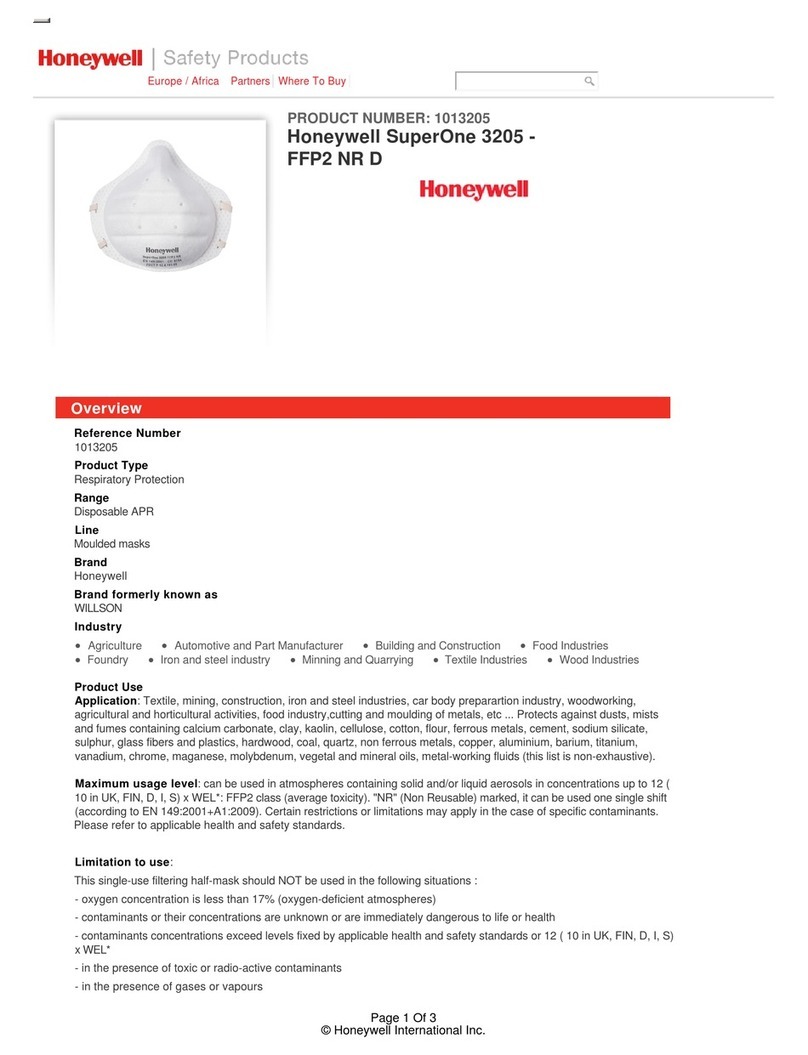
Honeywell
Honeywell SuperOne 3205-FFP2 NR D manual

North Safety Products
North Safety Products Air Filter Operating and maintenance instruction
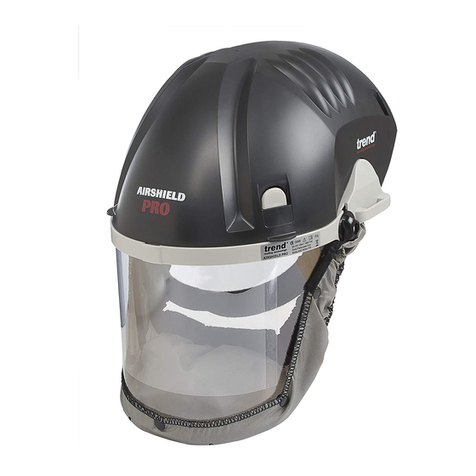
TREND
TREND AIRSHIELD PRO manual
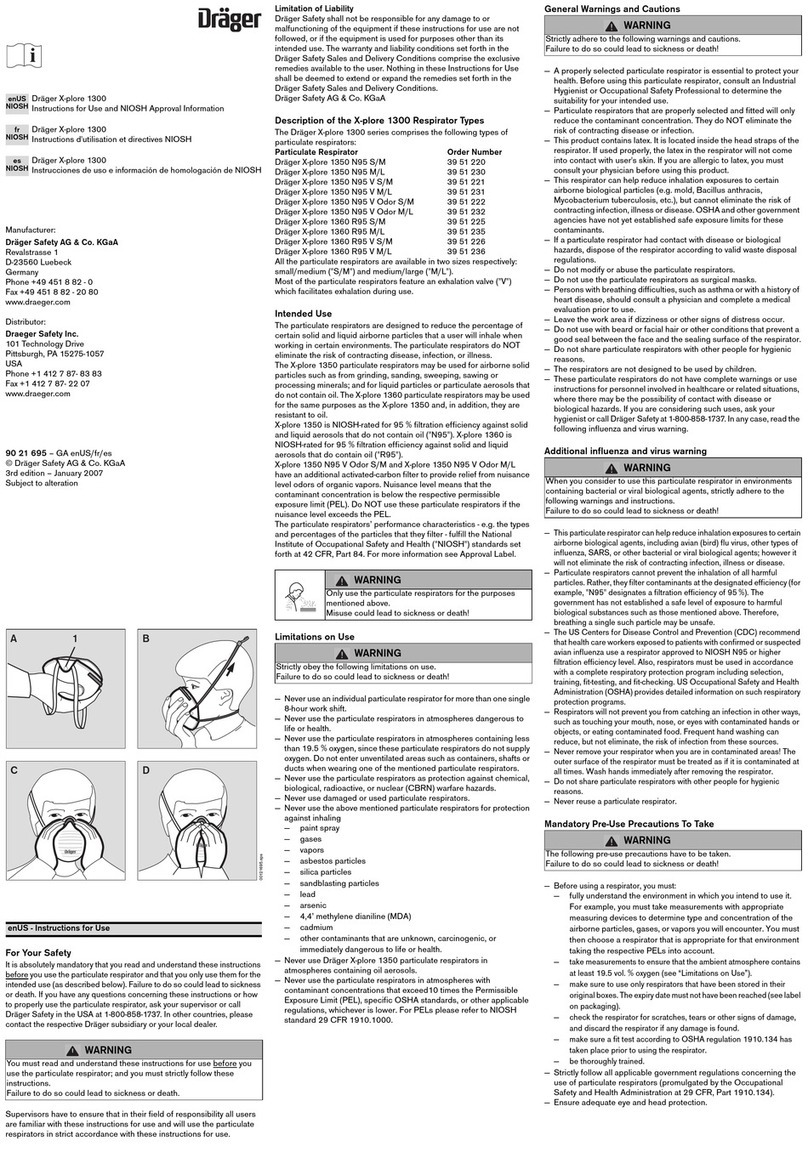
Dräger
Dräger X-plore 1300 Series Instructions for use

Omron
Omron DuoBaby NE-C301-AP instruction manual

Sundstrom
Sundstrom SR 90-3 Instructions for use

